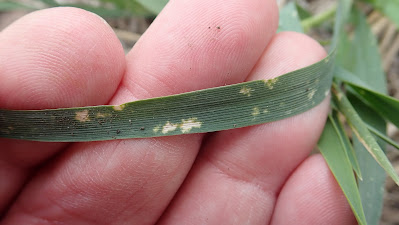Over the last two weeks pathologists in Alberta received reports of white flecking on leaves in wheat (June 13, 2022) and barley (June 4 and 14, 2022). The symptoms were not typical of fungal leaf spots including scald, net blotch, spot blotch in barley, or tan spot or the septoria complex in wheat. Here are some images of the symptoms that were observed recently (note click each photo to enlarge):
Barley:
Photo of white
flecking in barley courtesy of Brittany Turchyn, Territory Manager at Corteva
Agriscience, Peace River, Alberta, June 17, 2022. Field was managed as barley
(2022) seeded on barley stubble (grown 2021).
Photo of white
flecking in barley courtesy of Brittany Turchyn, Territory Manager at Corteva
Agriscience, Peace River, Alberta, June 14, 2022. Field was managed as barley (2022) seeded on
barley stubble (grown 2021).
Photo of white
flecking in barley courtesy of T. Kelly Turkington, AAFC Lacombe and Lorne
Campbell, Rahr Malting, Inc., central Alberta, June 16, 2022.
Photo of white
flecking in barley courtesy of T. Kelly Turkington, AAFC Lacombe and Lorne
Campbell, Rahr Malting, Inc., central Alberta, June 16, 2022.
Photo of white
flecking in barley courtesy of T. Kelly Turkington, AAFC Lacombe and Lorne
Campbell, Rahr Malting, Inc., central Alberta, June 16, 2022.
Photo of white flecking in barley growing in Sturgeon County on June 4, 2022, courtesy of Kristina Wormald (Polziehn), Axiom Agronomy.
Wheat:
Photo of white flecking in wheat courtesy of Ernie Nycholat, Manager Agronomic Solutions, Northern Alberta, east central Alberta, June 13, 2022.
Photo of white flecking in wheat courtesy of Ernie Nycholat, Manager Agronomic Solutions, Northern Alberta, east central Alberta, June 13, 2022.
Observations of white flecking in barley and/or wheat have
been reported from the Peace region (Brittany Turchyn/Mark Johns, Corteva
Agriscience), central Alberta (Lorne Campbell, Rahr Malting, Inc.; Ernie
Nycholat, Nutrien, Inc.) and the Edmonton region (Kristina Wormald (Polziehn), Axiom
Agronomy).
Following the sharp eye of Henry Klein-Gebbinck, pathologist AAFC Beaverlodge, and discussions of various pictures with Tyler Wist, AAFC Saskatoon, Jennifer
Otani, AAFC Beaverlodge, and Hector Carcamo and Haley Catton, AAFC Lethbridge,
it was concluded that the white flecking was due to feeding damage by the insect Trigonotylus coelestialium aka the rice-leaf
bug or green-grass bug. Apparently
according to Tyler Wist these insects produce digestive enzymes that result in
the whitish dead flecks on the leaves. Jennifer
Otani adds that all the Miridae or plant bugs are recognized for both physical
and chemical damage. This damage arises
from their mouthparts and the chemical cocktail they inject into the host plant
that facilitates the sucking or ingestion of phloem. Both the physical and
chemical damage leads to chlorosis or abscission, but it varies by mirid
species and host plant. Note the plant
structures they feed upon, and the tolerance or ability of the host plant to
cope with whatever density and feeding levels may arise, can be crop specific.
Jennifer Otani also adds that based on some pictures taken
June 17, 2022, from the Peace region courtesy of Brittany Turchyn, Territory
Manager at Corteva Agriscience, Peace River, Alberta, grass bug nymphs were identified and were likely in the 3rd – possibly 4th instar owing to presence of wing buds on a number of
the specimens in Brittany’s photos and their smaller size. Overwintered eggs very likely laid on 2021
barley then hatched in spring 2022 to develop and feed on newly seeded 2022
barley. Trigonotylus coelestialium is fairly commonly found in grasses
grown for seed across the Peace River region, but there are 1-2 other closely
related species that can also appear – sometimes as a complex in the same
field. Jennifer also indicated that
green grass bugs are common although high densities aren’t typical, yet many
species of grass bugs do well with heat – and we had a LOT of that last year.
Species belonging to the genus (usually greenish) Trigonotylus, Stenodema, Leptoturna, (and more blackish) Capsus, Labops, and Irbisia are
all genus in the Miridae family, commonly referred to as plant bugs. Some or
all of these genus can occur in grasses grown across the whole Peace River
region and they are associated with silvertop so this is a tip to watch any
grasses being grown for seed. However,
the monitoring/management window in all grass species grown for seed is quickly
coming to an end the week of June 17, 2022, across the south of the Peace River
region Jennifer indicated that field experiments
are underway in 2022 to assess and compare silvertop levels in creeping red
fescue grown for seed so hopefully helpful data can be collected. An important management consideration for
growers observing this type of damage now is to rotate affected 2022 cereal stands to
a broadleaf crop in 2023. The
mirids described above overwinter as eggs or adults so grassy- or cereal-type
stubble has the potential to harbor similar species in 2023 - just remember - all mirids are extremely
difficult to predict from year to year.
More detailed information related to these insect genus and species can be found in the (2018) insect field guide located here: https://www.researchgate.net/publication/360496020_Field_Crop_and_Forage_Pests_and_their_Natural_Enemies_in_Western_Canada_Identification_and_Management
Or the (2009) Alberta Forage Manual located here: https://open.alberta.ca/dataset/077326082x/resource/17d48b63-90bd-49b4-ad88-78a618febcd9
Both these guides are available as free, downloadable and
searchable PDF files.
Photos of green-grass bug nymphs courtesy of Brittany Turchyn, Territory Manager at Corteva Agriscience, Peace River, Alberta, June 17, 2022.








.jpg)

